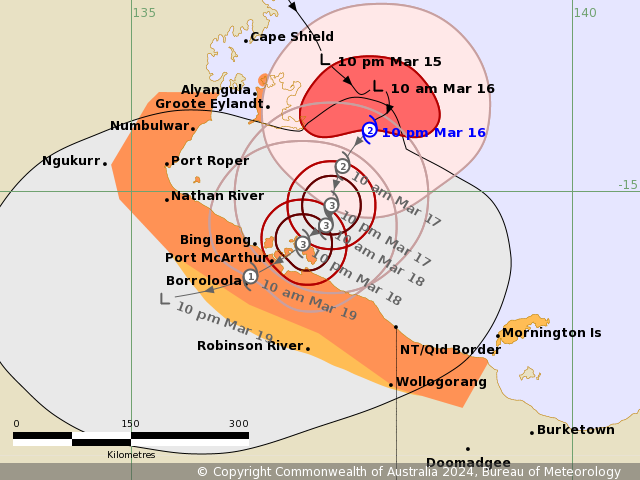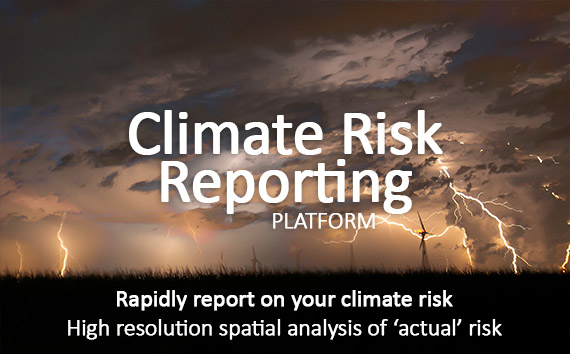Source: Bureau of Meteorology
Issued at 10:18 pm ACST [10:48 pm AEST] on Saturday 16 March
2024
Headline:
Tropical Cyclone Megan strengthening in the Gulf of
Carpentaria.
Areas Affected:
Warning Zone
Alyangula (Groote Eylandt) in NT to Mornington Island in Qld,
including Borroloola but not including Ngukurr or Mornington
Island.
Watch Zone
Mornington Island in Qld as well as adjacent parts of the
Carpentaria District inland to Robinson River in NT.
Cancelled Zone
None.
Details of Tropical Cyclone Megan at 9:30 pm ACST [10:00 pm
AEST]:
Intensity: Category 2, sustained winds near the centre of 95
kilometres per hour with wind gusts to 130 kilometres per
hour.
Location: within 30 kilometres of 14.3 degrees South 137.7 degrees
East, estimated to be 145 kilometres east southeast of Alyangula
and 250 kilometres northeast of Borroloola.
Movement: slow moving.
Tropical Cyclone Megan is to the east of Groote Eylandt and has
intensified to category 2 this evening. Megan is currently moving
slowly south towards the southern Gulf of Carpentaria coast and is
forecast to intensify further to Category 3 by late Sunday. Megan
is expected to cross the coast during Monday or early Tuesday
morning as a severe tropical cyclone between Nathan River and the
Northern Territory/Queensland border.
Once over land, Megan should weaken quickly as it tracks west
through the Northern Territory.
Hazards:
Gales with DAMAGING WIND GUSTS of 110 km/h are currently being
experienced over eastern Groote Eylandt and are expected to
continue into Sunday.
Gales with DAMAGING WIND GUSTS of 100 km/h are expected to develop
between Numbulwar in the Northern Territory and Mornington Island
in Queensland, including Borroloola, during Sunday morning. Gales
may extend inland to Robinson River overnight Sunday into Monday if
the system moves more quickly to the south.
Gales with DAMAGING WIND GUSTS of 100 km/h are possible on
Mornington Island itself from early Monday, if the system tracks
further east than forecast.
DESTRUCTIVE wind gusts in excess of 125 km/h are likely about the
southwestern Gulf of Carpentaria coast, near the system centre,
from late Sunday.
The VERY DESTRUCTIVE CORE of Tropical Cyclone Megan with wind
gusts up to 200 km/h is expected to cross the coast between Nathan
River in the Northern Territory and the Northern
Territory/Queensland border during Monday or early Tuesday
morning.
INTENSE RAINFALL is possible about Groote Eylandt and coastal
parts of the Carpentaria District during the weekend.
HEAVY RAINFALL is occurring over eastern parts of the Top End and
will continue over the weekend, with the heaviest falls in coastal
and island locations during today before extending further inland
on Sunday into the Carpentaria forecast district, as well as into
parts of the Gulf Country coast in Queensland.
Coastal residents between Nathan River and the Northern
Territory/Queensland border are specifically warned of a DANGEROUS
STORM TIDE as the cyclone centre crosses the coast. Tides are
likely to rise significantly above the normal high tide, with
DAMAGING WAVES and DANGEROUS FLOODING.
Recommended Action:
The Northern Territory Emergency Service advise:
For the communities in the area of the Cyclone Warning:
- Enact your household plan
- Prepare your property now
- Stay informed
- Take extra care on the roads
For the communities in the area of the Cyclone Watch:
- Prepare now
- Stay informed
- Monitor conditions
QFES advises:
People between the Queensland/ Northern Territory border and
Mornington Island, not including Mornington Island, should take
precautions and listen to the next advice.
People between on Mornington Island should consider what action
they will need to take if the cyclone threat increases.
- Information is available from your local government
- For cyclone preparedness and safety advice, visit Queensland's
Disaster Management Services website
(www.disaster.qld.gov.au)
- For emergency assistance call the Queensland State Emergency
Service (SES) on 132 500 (for assistance with storm damage, rising
flood water, fallen trees on buildings or roof damage).
Current
Tropical Cyclones

16/Mar/2024 01:11 PM



